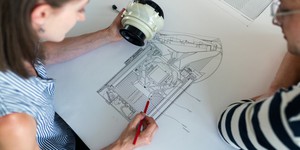Abstract
"Hey kids, step right up! Toss this ball and win a prize!" shouts the carny barker. Sounds easy enough—until you try it. Why are those "simple" games at the fairs, carnivals, and boardwalks so hard? Is it really lack of skill or coordination or do those concessionaires use some basic laws of science to help them set up the games in their favor? This science fair project can help you find out for yourself.Summary
Darlene E. Jenkins, Ph.D., and Teisha Rowland, Ph.D., Science Buddies
This project is based on a DragonflyTV episode.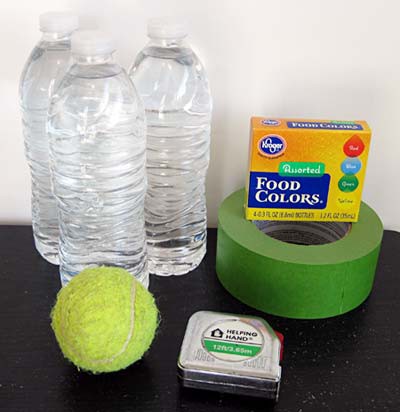
Objective
Investigate how changing the center of mass of a pyramid of bottles affects how easy it is to knock down the pyramid.
Introduction
"Hey kids, step right up! Toss this ball and win a prize!" Sounds easy enough—until you try it. Somehow knocking down enough pins or hitting the right target to win that giant stuffed animal ends up being nearly impossible to do. So what gives? Why are those "simple" games at the fairs, carnivals, and boardwalks so hard? Is it really lack of skill or coordination or do those concessionaires use some basic laws of science to help them set up the games in their favor?
One classic carnival game is where milk bottles are stacked up like a pyramid, as shown in Figure 1, and you get to throw a ball at them to try and knock them all over. Do you think this game, which is also sometimes called "One Ball" because you typically only get one throw with the ball, can be won by understanding some physics? To answer this, you will want to think about how spreading out the mass of an object can affect how well it balances. For example, you might find it easy to stand on a balance beam with a heavy backpack hanging down in front of you, but it gets quite a bit more challenging when that backpack is up on your back, or—even more difficult—being held over your head.
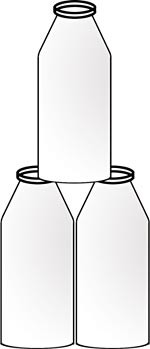 Image Credit
Image Credit
Figure 1. In one classic carnival game, milk bottles are stacked like a pyramid and the player gets one throw with a ball to knock all of the bottles down.
How the mass of an object is distributed can affect its center of mass. In physics, the center of mass of an object is a point where, for the purpose of various calculations, the entire mass of the object may be assumed to be concentrated. It basically means that the center of mass will be in the center of the object if the mass is uniformly distributed (as it is with a ball) and will shift to the object's heavier side if the mass is not uniformly distributed (as with a pyramid, or another object that is not perfectly symmetrical). So, if you have a see-saw with two equally heavy elephants on each side, the center of mass will be in the middle of the see-saw. If you take the same see-saw and swap a mouse for one of the elephants then the center of mass will shift. It will move away from the middle closer to where the remaining elephant is sitting, because that is where most of the mass is now concentrated.
So if we look at the pyramid of milk bottles again, can you figure out where its center of mass might be? It is actually between the two bottles at the bottom. A lot of people would think that it is in the middle of the structure—where the upper bottle rests on the lower ones—but because there are two bottles on the bottom, there is more mass on the bottom of the pyramid than the top, which moves the center of mass closer to the bottom of the pyramid.
In this science project, you will investigate how changing the center of mass of the bottle pyramid affects how easy it is to knock down the pyramid. You will test three pyramid arrangements, each with a different center of mass:
- First you will test the pyramid with all three bottles filled with water. As discussed, the center of mass will be between the two bottles on the bottom, just below the middle of the structure.
- Next you will test the pyramid with an empty bottle on top (and two filled ones on the bottom), which will shift the center of mass of the pyramid to be even lower. Do you understand why this is?
- Lastly you will test the pyramid with two empty bottles on the bottom (and one filled bottle on the top), which will shift the center of mass of the pyramid upwards, to be within the bottle at the top. Does is make sense why the center of mass shifts this way?
Which arrangement do you think will make it easiest to knock down the pyramid? In other words, how do you think the people who run the game could set it up to make it look easy for them to do when they give a "demonstration"? Which arrangement do you think will make it hardest to knock down the pyramid? To find out, gather up your bottles, ball, and other materials, set up your own "mini carnival," and run a few experiments. Then maybe you will be able to amaze yourself and your friends with the ways science can be used to make seemingly simple games surprisingly difficult!
Terms and Concepts
- Mass
- Balance
- Center of mass
Questions
- What determines the center of mass of an object?
- Can you think of some objects that have their center of mass in the middle of the object? What about objects that do not have their center of mass in the middle?
- How do you think changing the center of mass of an object affects how easy it is to balance?
Bibliography
Here are some websites and sources related to physics and carnival games for you to check out.
- Rader, A. (n.d.). Newton's Laws of Motion. Physics4Kids.com. Andrew Rader Studios. Retrieved May 1, 2007.
- Twin Cities Public Television, Inc. (2007). DragonflyTV, Twin Cities Public Television. Retrieved May 9, 2007.
- WIRED. (2019, October 12). Be Master of the Midway-With Physics! Retrieved May 11, 2023.
This book shows how to beat carnival and amusement park games.
- Richardson, B., 2002. The Secrets of Amusement Park and Carnival Games...Revealed!, Second Edition. Harrisburg, PA: Silver Star Publications.
Materials and Equipment
- A very large room, or an area outside, with plenty of space so you can throw a ball without injuring someone or breaking something!
- Small, stable table. The pyramid of bottles will be arranged on this table so make sure you can move it to the testing area.
- Tape measure
- Masking tape, a stick, a rock, or another object to help you mark the distance from the table that the bottles are on.
- A tennis ball or baseball. A different type of ball may be used, but you want it to be small enough so that it will easily hit only one bottle at a time in the pyramid, and heavy enough that it will be able to knock at least one bottle down.
- Plastic bottles filled with water (3). All three bottles should be the same shape and size. Make sure that you can stably stack the bottles in a pyramid shape. Most 16.9 fl. oz. drinking water bottles should work well for this.
- Optional: Food coloring
- Lab notebook
- Optional: Video camera and a tripod or helper
 Image Credit: Teisha Rowland, Science Buddies / Science Buddies Image Credit: Teisha Rowland, Science Buddies / Science Buddies
|
| Figure 2. To do this science project, you will need materials like the ones shown here. Note: The food coloring is optional, and you can use other objects instead of the masking tape. |
Experimental Procedure
Preparations for the Game
- Gather all your materials and find a good place to set up your mini carnival game.
- Put your table at a set distance from your "throw line." Record the distance in your lab notebook and be sure the table is always set at this distance throughout your experiment. You might try 2.5 meters (8 feet 2 inches). Mark the throw line using a piece of masking tape, a rock, a stick, or a similar object.
- In your lab notebook, make three data tables like Table 1, to record your results in. Leave space for recording data for at least 15 trials in each data table. Label one data table "All Three Bottles Filled," label the second data table "Bottom Bottles Filled," and the last data table "Top Bottle Filled."
| Trial | Bottle That Was Hit | Number of Bottles That Were Knocked Over |
| 1 | ||
| 2 | ||
| 3 | ||
| etc. |
Table 1. In your lab notebook, make three data tables like this one, leaving space for at least 15 trials in each data table.
Test Different Pyramid Arrangements
- Make sure each bottle is filled full with water. The same amount of water should be in each bottle.
- If you want, you can remove the labels from your bottles and add some food coloring (3 drops) to each bottle to give your carnival game some color.
- Note: If you add food coloring to the bottles, make sure you do your testing where it will not be a problem if a bottle spills dyed water on the floor or walls!
-
Stack the three bottles into a stable pyramid shape on the table, as shown in Figure 3. Make sure the lids are on tight.
- If you want to video tape your trials, now set the video camera up on the tripod (or have your helper get ready to record) so that the pyramid of bottles is in view and the camera is ready to record where your throw hits the pyramid.
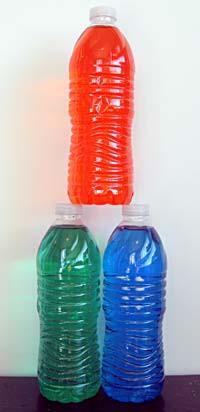 Image Credit: Teisha Rowland, Science Buddies / Science Buddies
Image Credit: Teisha Rowland, Science Buddies / Science Buddies
Figure 3. Stack the three water-filled bottles in a pyramid shape on the table.
- From your throw line, throw the tennis ball (or other ball) at the bottle pyramid. In the data table labeled "All Three Bottles Filled" that you made in your lab notebook, record which bottle was hit (either the top bottle, the bottom left bottle, or the bottom right bottle), and how many bottles were knocked over.
- If no bottles were knocked over, do not count this trial and try your throw again.
- Repeat steps 3 and 4 at least 14 times for a total of at least 15 trials.
- Try to throw the ball the same way each time.
- Try to hit each bottle an equal number of times, but do not worry if this is not possible.
- Now take the top bottle from the pyramid and empty the water out of it.
- Stack the bottles into a stable pyramid shape on the table with the empty bottle on the top, as shown in Figure 4.
- Again, if you want to video tape your trials, set that up now.
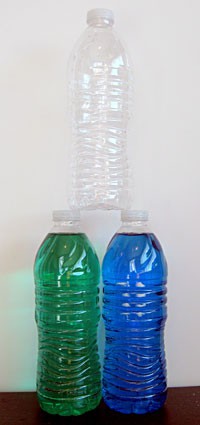 Image Credit: Teisha Rowland, Science Buddies / Science Buddies
Image Credit: Teisha Rowland, Science Buddies / Science Buddies
Figure 4. Empty water from the top bottle and place it back on the top of the pyramid.
- From your throw line, throw the tennis ball at the bottle pyramid. In the data table labeled "Bottom Bottles Filled" that you made in your lab notebook, record which bottle was hit (either the top bottle, the bottom left bottle, or the bottom right bottle), and how many bottles were knocked over.
- If no bottles were knocked over, do not count this trial and try your throw again.
- Repeat steps 7 and 8 at least 14 times for a total of at least 15 trials.
- Try to throw the ball the same way each time.
- Try to hit each bottle an equal number of times, but do not worry if this is not possible.
- Lastly take one of the bottom bottles from the pyramid and empty the water out of it.
- Stack the bottles into a stable pyramid shape on the table with the two empty bottles on the bottom and the water-filled bottle on the top, as shown in Figure 5.
- Again, if you want to video tape your trials, set that up now.
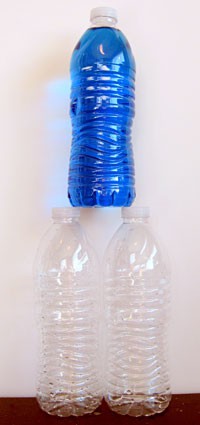 Image Credit: Teisha Rowland, Science Buddies / Science Buddies
Image Credit: Teisha Rowland, Science Buddies / Science Buddies
Figure 5. Empty water from one of the bottom bottles and arrange the pyramid so that the only filled bottle is now on the top of the pyramid.
- From your throw line, throw the tennis ball at the bottle pyramid. In the data table labeled "Top Bottle Filled" that you made in your lab notebook, record which bottle was hit (either the top bottle, the bottom left bottle, or the bottom right bottle), and how many bottles were knocked over.
- If no bottles were knocked over, do not count this trial and try your throw again.
- Repeat steps 11 and 12 at least 14 times for a total of at least 15 trials.
- Try to throw the ball the same way each time.
- Try to hit each bottle an equal number of times, but do not worry if this is not possible.
Analyze Your Data
- Using the data from your data tables, calculate how often all 3 bottles were knocked over in each pyramid arrangement. Record your results (as a percentage) in your lab notebook.
- For example, if in one pyramid arrangement you had 7 trials where all 3 bottles were knocked down and you did a total of 15 trials for that arrangement, this means that all 3 bottles were knocked down in 47% of the trials for that arrangement (since 7 divided by 15 is 0.47, which is 47%).
- Next make a data table in your lab notebook similar to Table 2. For each pyramid arrangement, calculate the average number of bottles that were knocked over when each bottle was hit in the arrangement. Fill out the data table based on your calculations.
- For example, if in the "All Three Bottles Filled" pyramid arrangement you hit the bottom left bottle in 5 trials, and in 3 of these trials 2 bottles were knocked down and in 2 of these trials 3 bottles were knocked down, the average number of bottles knocked down by hitting the bottom left bottle in this arrangement would be 2.4 (because 2 + 2 + 2 + 3 + 3 = 12, and 12 divided by 5 is 2.4).
| Pyramid Arrangement | |||
| Bottle That Was Hit | All Three Bottles Filled | Bottom Bottles Filled | Top Bottle Filled |
| Top | |||
| Bottom Left | |||
| Bottom Right | |||
Table 2. In your lab notebook, make a data table like this one to record the average number of bottles knocked over when each bottle was hit for each pyramid arrangement.
- Make two bar graphs of your results. You can make your graphs by hand or using a computer program.
- Make one graph that shows the percentages you calculated in step 1. On the x-axis (the horizontal axis), put the pyramid arrangement, and on the y-axis (the vertical axis), put the percentage of trials where all three bottles were knocked over.
- Make a second graph that shows your data from the data table you made that is similar to Table 2. On the x-axis (the horizontal axis), put the pyramid arrangement, and on the y-axis (the vertical axis), put the number of bottles knocked over. For each pyramid arrangement, make three bars, one for each bottle that was hit (top, bottom left, or bottom right). This means you should end up with 9 bars total on this graph.
- Analyze your graphs and other data and try to draw some conclusions.
- Which pyramid arrangement led to the highest percentage of trials where all three bottles were knocked over? In other words, which arrangement was most successful? Which was least successful?
- Which bottle(s) should be hit to cause the largest number of bottles to fall down? Is it different with the different pyramid arrangements, or is it similar?
- Can you explain your results in terms of center of mass? Hint: If you are stumped, try re-reading the Introduction.
- How do you think somebody running this carnival game could use your results to rig the game, making it look easy to do when they try it, but then making it almost impossible when you throw a ball?
Ask an Expert
Global Connections
The United Nations Sustainable Development Goals (UNSDGs) are a blueprint to achieve a better and more sustainable future for all.
Variations
- Repeat this experiment but try moving the table a little closer. Be sure to record the new distance between your throwing line and the table. Does moving the table affect your results?
- Try different arrangements of the bottles, and/or filling them with different amounts of water. How do these changes affect your results? Can you design an arrangement that is even easier, or harder, to knock over than any of the ones in the original experiment?
- You could try using wooden blocks instead of bottles and arrange the blocks in different configurations, such as stacking all three on top of each other. Which configuration is easiest to knock over? Which is hardest?
- Repeat this experiment but compare different balls and/or pitching techniques (change the spin on the ball; increase the speed of the ball).
- If you have another table that is shorter or taller, does the height of the table (or the angle of the throws) make a difference in how successful your pitches are in knocking over all three bottles?
- You could ask some volunteers to repeat your experiments. Does more data help to clarify the results?
- Look into the science behind other carnival games. Can you design a way to test another game to figure out how you can improve your chances of winning?
Careers
If you like this project, you might enjoy exploring these related careers:





